The numerical model of EBIS is presented. The calculation
of Kr ionization by cooling with Ne ions was carried out taking
into account charge exchange, ion heating by electrons, ion-ion
energy exchange and ion escape processes. A good agreement with
experimental data was observed. According to the model, the processes
of Pb ionization in EBIS at close to ultimate parameters (the
electron beam current is 10 A and the electron energy is 10 keV,
the trap capacity is about 1012 e) by cooling with
Ne ions were simulated.
The electron-beam method of multicharge ion production
was suggested by E.D.Donets in 1967 [1]. The first attempt to
create an Electron-Beam Ion Source (EBIS) theory was undertaken
by R.Becker [2] and M.C.Vella in 1981 [3]. A more complete theory
of the electron-beam method of multicharge ionization in an ion
trap was created by the Livermore EBIT group (M.Levine, M.Penetrante,
R.Marrs et al.) [4,5]. Based on these results, we present a simpler
numerical model of multicharge ionization in EBIS. Simplifications
follow from our previous papers [6,7]. The computer codes describing
the Kryon-S experimental data can be used to predict EBIS basic
parameters: charge state spectrum, ion-beam current and even ion
temperatures.
According to the Livermore papers, main processes
in the EBIS trap are the following:
-electron-impact ionization of ions,
-radiative recombination of ions,
-charge exchange between ions and neutral atoms,
-ion heating by an electron beam,
-ion-ion energy exchange,
-ion confinement in the trap,
-ion escape from the trap.
The processes were considerated in detail in previous
parers [4,5,8,10].
We suppose that the ionization proceed by single
steps:
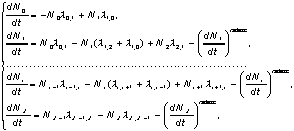
where N0 .. NZ are the ion and atom densities,
0,1 , 1,2 ,
i-1,i , i,i+1 , Z-1,Z are the ionization
coefficients: je is the electron
current density, i,i+1 the ionization cross-section,
1,0 , 2,1 , i+1,i , i,i-1 , Z,Z-1 are the recombination and charge exchange coefficients:
i,i-1=r +p
,where , r is the recombination
cross-section,
p is
the charge exchange cross-section, N0 is the
density of neutral atoms, <Vi> is the
mean ion speed,
is the rate of ion diffusion
escape from the trap.
The corresponding energy evolution is described by:
where kTi is the ion temperature,
the rate of ion heating
by the electron beam,
the rate of ion-ion energy
exchange due to Coulomb collision,
the rate of the energy loss
due to escaping ions.
The dependences of Kr ion densities, electron beam compensation values, Kr ion temperatures on time at taking into account ionization, charge exchange, ion heating by the electron beam, ion energy exchange and ion escape processes were calculated in [10].
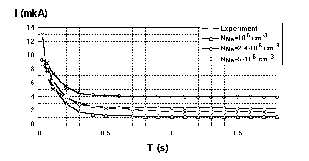
The experimental data of the Kr current at the EBIS
Krion-S exit measured over an ion extraction time of 100 s and
the calculated results obtained at je=1.771021
1/(cm2s), Ue=7103 eV, NKr(0)=6109
cm-3, rp=0.015 cm, B=1.2 T, by cooling Kr
ions with Ne ones.
The next step was to consider ion cooling processes.
The method of ion cooling in EBIS was suggested by E.D. Donets
and G.D. Shirkov [8]. Equation systems for charge and energy evolution
created for Kr and Ne were solved simultaneously. We supposed
that the concentration of Ne atoms (N0) in the electron
beam is a constant [10].
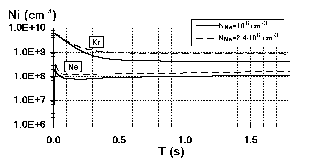
The calculated results for Kr ionization by cooling with Ne ions were compared with the experimental data of Kr current measurements at the EBIS Krion-S exit. The experimental current dependence on time was measured over an ion extraction time of 100 s. The best numerical approximation was obtained at the current density equals to je=1.771021 1/(cm2s), the electron energy Ue=7103 eV, the start concentrations of Kr atoms NKr(0)=6109 cm-3, the electron beam raius rp=0.015 cm and the magnetic field induction B=1.2 T. The results for output current are shown in Fig. 1. The total numbers of ions, the values of beam compensation and the average ion temperatures corresponding to Fig. 1 are shown in Fig. 2, Fig. 3, Fig. 4.
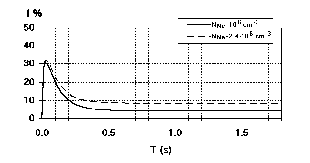
The time evolution of Kr ion densities at NNe=2.4106
cm-3 corresponding to Fig. 1 is shown in Fig.
5.
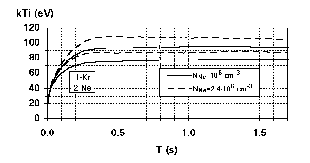
The results were confirmed by an experimental observation of Kr higher charge state evolution at the LU-20 output when the EBIS Krion-S was installed on the linac pre-injector [9].

According to the model, the processes of Pb ionization
in EBIS at close to ultimate parameters (the electron beam current
is 10 A and the electron energy is 10 keV) were simulated. The
electron gun for the source with the perveance equals to 3 A/V3/2
at the cathode diameter of 3.4 mm, the cathode emission density
of 111 A/cm2, the first anode voltage of 22.3 kV and
the second anode one of 10 kV can be produced in the firm "ISTOK"
(Friasino, Moscow reg., Russia) [11]. After instalation of the
e-gun in the EBIS, the value of DC current power at the EBIS collector
will be equal to 100 kW.
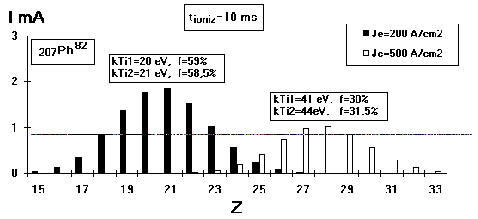
To avoid problems due to collector heating a pulse
regime of ionization is suggested. At the pulse duration is about
t0.1 s the collector system can be cooled by water at the rate
of flow is about G3 l/min. We suppose that the process of electron
beam formation to reach the current density 200je500 A/cm2
(as it takes place in Krion-S) won't be a very difficult
problem. The time of ion extraction from the trap can be decreased
from 100 s to 10 s. Therefore we carried out calculations of Pb
atom ionization processes during 0.1 s at je=200 A/cm2
and je=500 A/cm2 by cooling the Pb ions
with Ne ones and without one.
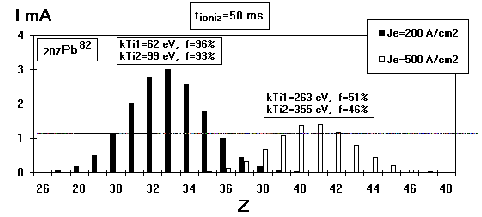
The results for output ion currents at the ion extraction
time of 10 s for different ionization periods are shown in Fig.
6, Fig. 7, Fig. 8. In the calculations, the values of Pb ion currents
for calculations with cooling are very close in amplitude
to ones without cooling at the same ionization
period. Therefore we present the ion currents for calculations
with cooling only. The electron beam compensation values f and
the average ion temperatures presented for both calculation types
(with cooling- kTi1 and without one- kTi2) are shown above the
currents.
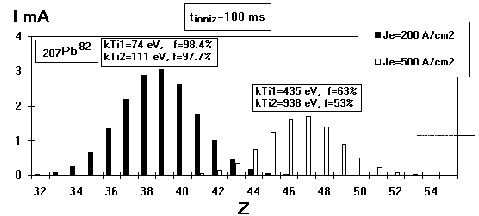
The workable numerical model of EBIS has been created.
The calculated results for Krion_S are close to the experimental
ones. The model made more understandable the influence of different
processes in the trap on the EBIS output parameters. It allows
us to undertake some attempts to predict future results.
The authors are very grateful to Dr. E.D. Donets
and Dr. G.D. Shirkov for their interest in the model and useful
discussions. Thanks also to the SUN computer system manager S.A.
Ivanovsky (JINR LNR) for providing our calculations.
[1] E.D. Donets, Soviet Invention #248860 of 16.03.67, Bull. OIPOTZ, #24, p.65 (1967 )
[2] R. Becker in Proc. of the 2-nd EBIS Workshop, Saclay-Orsay, p.185 (1981)
[3] M.C. Vella, Nucl. Instr. Meth. 187, p. 313 (1981)
[4] M.A.Levine et al. Phys. Scripta. V T22, p. 157 (1988)
[5] B.M.Penetrante et al. Phys. Rev. A 43, p. 4861 (1991)
[6] B. Sh. Bochev et al. JINR Preprint P5-11566 (1978)
[7] B. Sh. Bochev et al. JINR Preprint P7-11567 (1978)
[8] E.D. Donets, G.D. Shirkov, Soviet Invention #1225420 Bul. #44, p.69 (1989)
[9] V.P. Ovsyannikov, Proc. of the 1994 LINAC Conf. Tsukuba, Japan, p.384 (1994)
[10] I.V. Kalagin, V.P. Ovsyannikov, JINR Preprint E9-96-128 (1996)
[11] O. Kultashev, V. Ovsyannikov, Proc. of the 1994 LINAC Conf. Tsukuba, Japan, p.384 (1994)